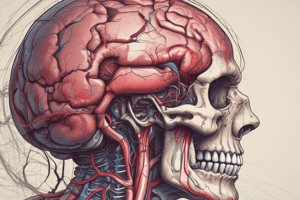Podcast
Questions and Answers
What is the primary location of bleeding in a subarachnoid hematoma?
What is the primary location of bleeding in a subarachnoid hematoma?
What is the most common cause of subarachnoid hematoma?
What is the most common cause of subarachnoid hematoma?
What is often described as a characteristic symptom of subarachnoid hematoma?
What is often described as a characteristic symptom of subarachnoid hematoma?
What is the initial diagnostic test for subarachnoid hematoma?
What is the initial diagnostic test for subarachnoid hematoma?
Signup and view all the answers
What is the primary goal of immediate medical attention in subarachnoid hematoma?
What is the primary goal of immediate medical attention in subarachnoid hematoma?
Signup and view all the answers
What is often required for patients with subarachnoid hematoma after hospitalization?
What is often required for patients with subarachnoid hematoma after hospitalization?
Signup and view all the answers
Study Notes
Definition and Pathophysiology
- A subarachnoid hematoma (SAH) is a type of bleeding that occurs in the space between the arachnoid and pia mater, the two innermost layers of the meninges that surround the brain.
- It is a life-threatening condition that can cause rapid neurological deterioration and death.
- SAH occurs when a blood vessel in the brain ruptures, releasing blood into the subarachnoid space.
- The bleeding can cause damage to the brain tissue, leading to cerebral edema, increased intracranial pressure, and potential herniation.
Causes and Risk Factors
- Rupture of an intracranial aneurysm (75-80% of cases)
- Arteriovenous malformations (AVMs)
- Trauma (head injury)
- Blood clotting disorders (e.g., hemophilia)
- Familial predisposition
- Hypertension
- Smoking
- Age (increased risk with age)
Symptoms and Signs
- Sudden and severe headache (often described as the "worst headache of my life")
- Nausea and vomiting
- Confusion and altered mental status
- Seizures
- Focal neurological deficits (e.g., weakness, numbness, or vision changes)
- Neck stiffness and pain
- Photophobia
- Fever
Diagnosis
- Non-contrast CT scan of the head (initial diagnostic test)
- Lumbar puncture (if CT scan is negative or equivocal)
- Cerebral angiography (to identify the source of bleeding)
- MRI (may be used in some cases, but not as sensitive as CT scan)
Treatment and Management
- Immediate medical attention is crucial
- Stabilization of the patient's airway, breathing, and circulation
- Neurointensive care unit (NICU) admission
- Blood pressure control
- Pain management
- Anti-seizure medication
- Surgical or endovascular intervention to secure the aneurysm or AVM
- Rehabilitation and follow-up care after hospitalization
Studying That Suits You
Use AI to generate personalized quizzes and flashcards to suit your learning preferences.
Description
Learn about the causes, symptoms, diagnosis, and treatment of subarachnoid hemorrhage (SAH), a life-threatening condition that occurs when a blood vessel in the brain ruptures.




